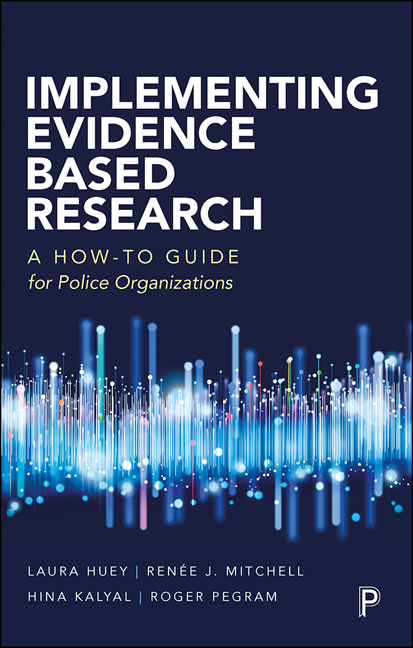Book contents
- Frontmatter
- Contents
- List of tables and figures
- Acknowledgments
- Introduction
- 1 Implementing evidence-based policing
- 2 Situating evidence-based policing
- 3 Understanding research
- 4 The individual approach
- 5 The smaller agency
- 6 The mid-sized agency
- 7 The larger agency
- 8 Generating sustainability
- 9 Resources for evidence-based practices
- Endnotes
- References
- Index
1 - Implementing evidence-based policing
Published online by Cambridge University Press: 05 January 2022
- Frontmatter
- Contents
- List of tables and figures
- Acknowledgments
- Introduction
- 1 Implementing evidence-based policing
- 2 Situating evidence-based policing
- 3 Understanding research
- 4 The individual approach
- 5 The smaller agency
- 6 The mid-sized agency
- 7 The larger agency
- 8 Generating sustainability
- 9 Resources for evidence-based practices
- Endnotes
- References
- Index
Summary
The entire premise of evidence-based policing (EBP), with its emphasis on ‘what works’, should, in theory, be of immense appeal to police services. After all, we have a sizeable body of research that shows how programs and strategies based on sound research can contribute significantly to police effectiveness and efficiency (Lum, 2009). For example, proactive strategies such as CompStat (Computerized Statistics), problem-oriented policing (POP), intelligence-led policing (ILP) (Ratcliffe, 2008), and hotspots policing (Sherman and Weisburd, 1995) have been found to be more effective compared to random and reactive models. Research by Braga and Weisburd (2010) shows that an evidence-based approach was effective in reducing crime when adopted by police services in the USA by helping officers to focus on areas with a greater incidence of crime. And yet, despite such research, uptake of EBP by police organizations has generally been rather slow (Lum et al, 2012). Why is that?
In this chapter, we take an organizational perspective, looking first at factors that affect police receptiveness to EBP, and then later identifying factors that affect resistance. Our goal: to help both police practitioners and their services move beyond various institutional obstacles and stumbling blocks.
Factors affecting receptivity to evidence-based policing Practices
Evidence-based practices are expected to help police organizations enhance their knowledge base, effectiveness, and economic efficiency (Bierly et al, 2009). One would assume that given the noted benefits of EBP, there would be abundant research identifying factors that help foster receptivity and reduce resistance to these practices. Surprisingly, such studies are few and far between, and a majority of them do not provide a clear idea about the impact of organizational context on embedding EBP in police organizations. So what is organizational context, and why should we care? Allow us to explain.
Organizational context refers to the factors that make up the external and internal organizational environment. These factors, individually and collectively, can have the capacity to impede or facilitate organizational change. External environments include political, social, economic, or technological factors (Spector, 2011), while the internal organizational environment comprises of institutional resources, organizational structure, culture, and prior experience of change (Reichers et al, 1997).
Information
- Type
- Chapter
- Information
- Implementing Evidence Based ResearchA How-to Guide for Police Organizations, pp. 15 - 26Publisher: Bristol University PressPrint publication year: 2021
